There’s no need to wait until summer to start enjoying produce from your garden. Many favorite vegetables grow best when the days are a bit shorter and the weather is a little cooler. You don’t even need to wait for the final frost date to pass. In most cases, once you can start working the soil, you can plant these 11 favorites.
If you want to grow more unusual or care-intensive vegetables, consider other cool-season annual crops such as Brussels sprouts, cabbage, cauliflower, celery, Chinese cabbage, collards, fennel, garlic, leeks, parsnips and turnips. If you’re looking for something more permanent, you can add asparagus and rhubarb, both of which are perennials.
More: Learn more about growing cool-season vegetables
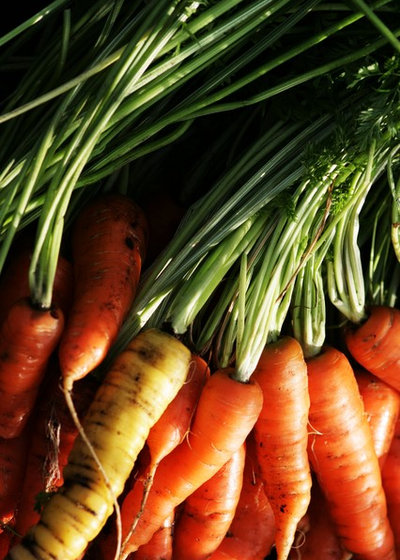
Laara Copley-Smith Garden & Landscape Design
1. CarrotsWhen to plant: Sow seeds in early spring.
Harvest: In one to three months, depending on the variety.
Homegrown carrots have a flavor you just can’t often find in grocery store bunches. Fortunately, carrots grow quickly and easily and are perfect for a spring garden. Growing your own also means you can choose exactly what type (short and squat, long and lean, round or heart shaped) and what color, including white and purple, you want.
Carrots require loose, well-drained soil that’s been amended before planting, which ideally is in early spring. Carrot seeds are also extremely tiny, so you’ll sow and cover them and then end up thinning as the crop comes in. Don’t worry about losing some of your crop; the thinnings are also good to eat.
Carrots, even more than most vegetables, require regular and consistent water to thrive. They also do best in full sun. Insects may cause some damage when the plants are young, but carrots are generally disease free.
See how to grow carrots
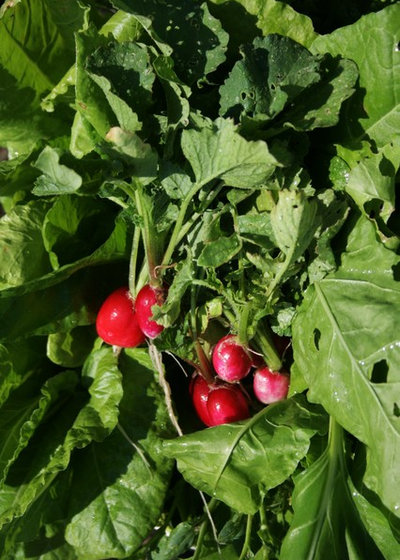
Laara Copley-Smith Garden & Landscape Design
2. RadishesWhen to plant: Sow seeds in early spring once the ground is workable, about two to three weeks before the final anticipated frost date, then continue sowing every two weeks until the hot summer days to ensure a continuous crop.
Harvest: In as little as three weeks. The earlier you harvest, the sweeter the radishes will be. If you leave them too long, they will get tough.
Radishes are the ultimate quick-reward vegetable. You can harvest them in as little as three weeks. They also aren’t usually troubled by pests, so they’re ideal for beginning gardeners and children, who will be encouraged by instant success in the vegetable garden.
Radishes do best in loose, well-drained soil in full sun. Provide regular water throughout the growing season and remove weeds when they appear.
See how to grow radishes
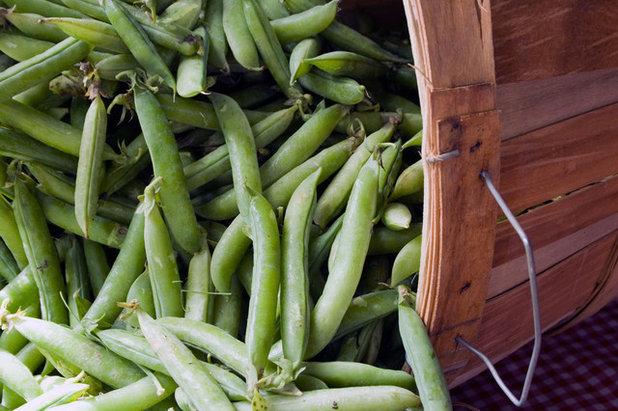
The New York Botanical Garden
3. PeasWhen to plant: Sow seeds about two months before the last frost date in spring.
Harvest: Peas are ready to harvest in 55 to 70 days; pick from the bottom up to encourage further production.
Garden peas are the very definition of a spring vegetable. The bright green pods and delicate peas themselves can enliven many spring dishes. English, or shelling, peas include both the familiar climbing varieties and the smaller bush varieties. Edible-pod peas, or sugar peas, can be eaten in the pod and generally grow as climbers.
Use inoculated seeds and start planting about two months before the anticipated final frost date for your area. Put in any supports for the climbing varieties when you plant. Keep the soil moist while the seeds are germinating, then provide regular water throughout the growing season. Peas like full sun except in areas with hot afternoons; you’ll need to provide some shade during those periods. Problems may include aphids, beetles and powdery mildew.
See how to grow peas
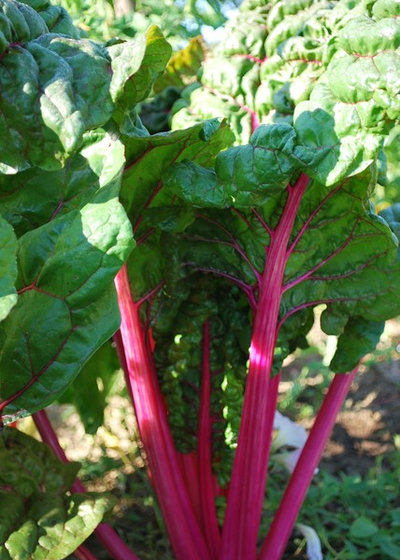
Bethesda Garden Design llc
4. ChardWhen to plant: Sow seeds or set out seedlings in late winter (in mild climates) or early spring when you can start to work the soil.
Harvest: Plants mature in about two months.
Chard is one of the more colorful spring vegetables. Its height, large veined leaves and often colorful stalks make it a great choice for a landscape with both vegetables and ornamental plants. It’s also long lasting and easy to grow. Best of all, you don’t have to harvest it all at once. You can eat the new leaves you get when thinning the plants, regularly harvest the outer leaves to encourage continued growth and even cut the plant off at the base and see it regenerate.
Keep the soil moist while the seeds are germinating, then provide regular water throughout the growing season. Provide full sun unless you’re in a hot climate; then you’ll need to provide some afternoon shade. Occasional pests include aphids, leaf miners, snails and slugs.
See how to grow chard
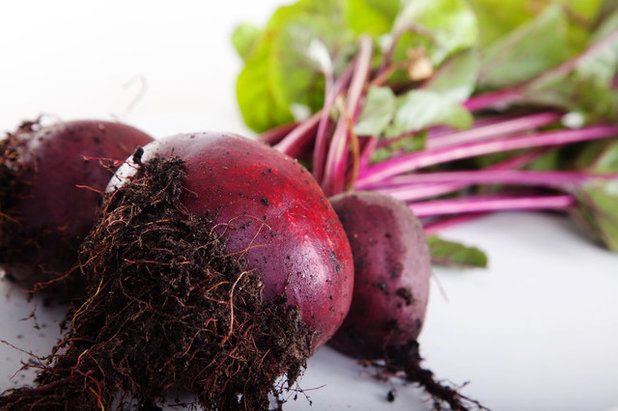
Laara Copley-Smith Garden & Landscape Design
5. BeetsWhen to plant: Sow seeds in late spring. Sowing every couple of weeks will ensure a continuous crop until hot weather sets in.
Harvest: You can start to harvest in 45 to 60 days, depending on the variety.
Eat beets fresh from the garden and you’ll never look at them the same way again. Their leaves and roots have a flavor you won’t forget. You can also experiment with different varieties — something that isn’t always possible with grocery store versions. Who says beets have to be deep red?
Beets do best in sun or partial shade. They also need loose, well-drained soil that’s free of clogs or roots that can inhibit growth. Thin plants to 2 inches apart (and eat the thinnings). Pests are few, but you’ll probably want to mulch around the plants to discourage weeds and keep the ground cool.
See how to grow beets
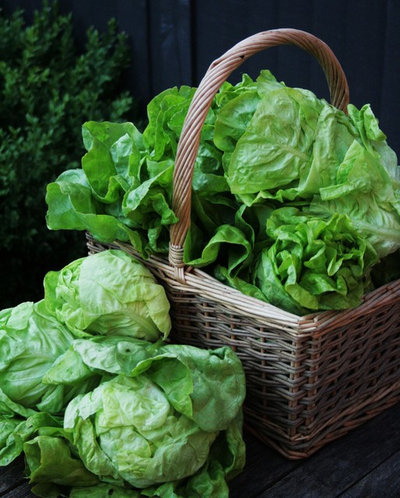
Laara Copley-Smith Garden & Landscape Design
6. Lettuce When to plant: Sow seeds or set out seedlings in early spring.
Harvest: Start harvesting after about 30 to 90 days, depending on the type of lettuce.
No spring vegetable garden is really complete without lettuce. For one thing, it really is a cool-season crop; as any gardener who has experienced lettuce bolting or going to seed can tell you, it doesn’t like warm weather. But in spring it thrives.
Having lettuce in your garden means you can pick just what you need for a salad or sandwich without having the rest wilt in the refrigerator. You can plant in succession so fresh leaves are readily available. You also can enjoy mixing and matching different types in one space or adding other salad greens.
Plant seeds or seedlings in full sun to partial shade. As the season progresses, having other plants shade the lettuce will help prevent bolting. Water regularly. You might run into problems with aphids, leaf miners, mildew and wilt, and you might also have to protect your crop from birds and small animals.
See how to grow lettuce and salad greens.
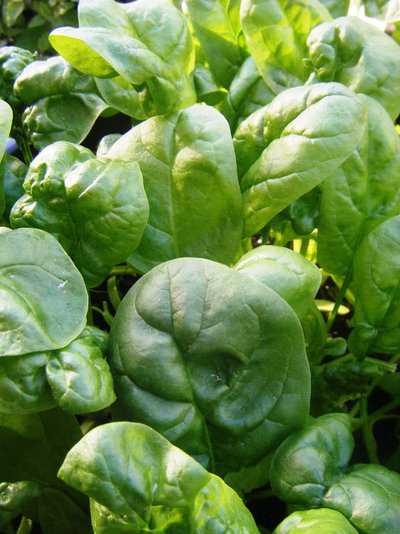 7. SpinachWhen to plant:
7. SpinachWhen to plant: Sow seeds or set out seedlings once the soil can be worked, as early as two months before the last expected frost date, then keep sowing every three weeks until just past that frost date for a continuous crop.
Harvest: Harvest after about three weeks to five months, depending on variety. You can harvest a few leaves at a time or cut off the entire plant about an inch from ground level so it will regrow.
Like lettuce, spinach loves the cool spring weather and bolts quickly once the hot weather and long days of summer begin. But in spring you can grow any of the three main types of spinach: crinkly, semicrinkly and flat-leafed.
Spinach does best in full sun to light shade; lean toward the latter if afternoons get hot where you live. Keep the soil around the plants well weeded and moist but not too wet. You might run into problems with aphids, cabbage worms and leaf miners.
See how to grow spinach
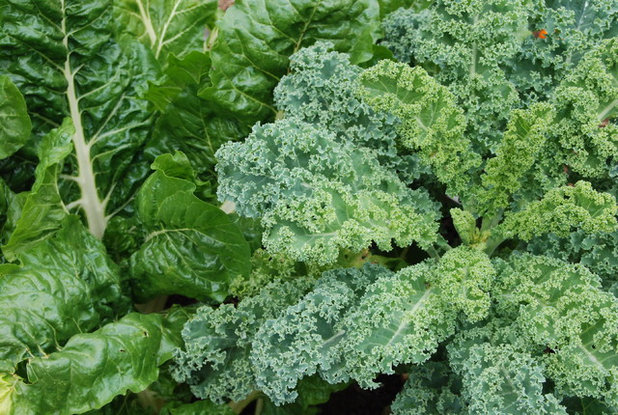
Paintbox Garden
8. KaleWhen to plant: Ideally, start kale from seed or put transplants out in the garden in late winter or early spring, about two months before the expected final frost date, provided the soil can be worked.
Harvest: You can start harvesting in about 55 to 75 days, depending on variety. Pull up the entire plant or simply take the outer leaves.
Lettuce and spinach may love cool weather, but kale absolutely adores it. This superfood is an easy-to-grow choice for the early-spring garden.
A sunny spot will work well, although if you anticipate hot afternoons, you’ll want to choose an area with light shade during that time. Provide regular and consistent water and stake the plant if you have a tall variety. Kale is seldom bothered by pests.
See how to grow kale
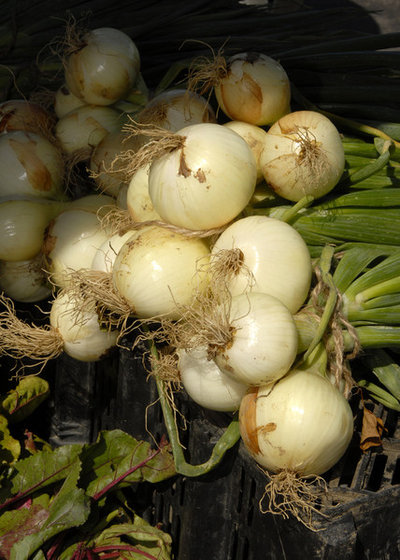
The New York Botanical Garden
9. OnionsWhen to plant: Plant seeds or transplant sets about four to six weeks before the last frost date and when the soil has warmed up to about 50 degrees Fahrenheit.
Harvest: Begin harvesting about two to five months after planting, depending on variety. Green onions can be picked and used. Larger onions will need to be prepared before harvesting and then dried.
There are a lot of options for homegrown onions out there, so if you’re confused about which to buy, the general guidelines are that long-day varieties are best for northern gardens, short-day varieties do better in southern gardens, and intermediate varieties usually do well almost anywhere. After that, it’s up to you to choose green onions or larger onions, your desired colors and how sweet or sharp the onions are.
Choose a spot in full sun (although onions can handle some light shade). Water regularly and watch for pests such as thrips and wireworms and for downy mildew.
See how to grow onions
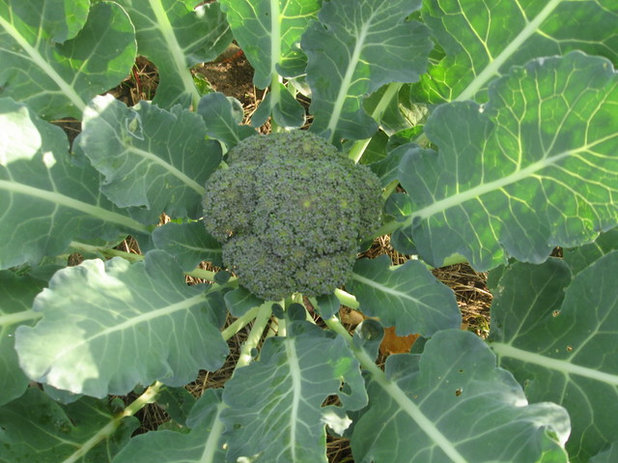 10. BroccoliWhen to plant:
10. BroccoliWhen to plant: Start seeds indoors about six weeks before the last frost date in spring; set out transplants two weeks before the final frost date.
Harvest: Broccoli reaches maturity in 50 to 100 days. Cut slightly below the head to encourage side shoots.
Broccoli may be a dinner table staple, but it can be a bit of a challenge in a vegetable garden. It takes more care than some of its fellow cool-season edibles, and it’s also more prone to pests and problems. But if you want a bit of a challenge, it’s worth trying.
Broccoli is another of those cool-season crops that withers in warm weather. Plant it in rich, well-amended soil. Choose a spot in full sun to light shade. Water regularly and evenly, mulch to help retain moisture and fertilize just before the heads form. Keep an eye out for any number of problems, from aphids to wilt, and act quickly if you see anything.
See how to grow broccoli
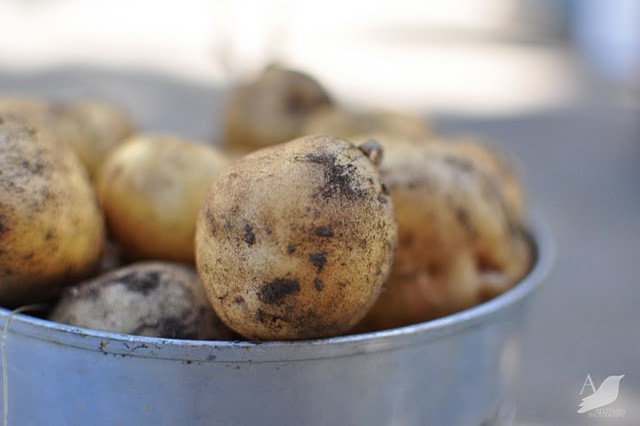
Amy Renea
11. PotatoesWhen to plant: Get seed potatoes in the ground as early as reasonably as you can in the spring, because potatoes won’t grow if the soil is too warm. The recommendations call for four to six weeks before the last frost date.
Harvest: Potatoes reach maturity in three to four months, but you can harvest “new” potatoes once the vines start to flower, usually around two months.
While you might think of potatoes as needing a lot of space, you can grow them in a large barrel. So there really is no reason not to add them to a cool-season edible garden. With the number of varieties out there, you can even have your own potato-tasting party.
Use certified seed potatoes and cut them into chunks with at least two eyes. Set them in rich and fast-draining acidic soil in full sun with the eyes facing up. Cover with soil, then continue to mound soil on top as the sprouts emerge. Provide regular water and keep weeds down.
Caution: The tuber is edible unless it has turned green. Green spots on the tuber and all other parts of the plant are poisonous.
See how to grow potatoes
Region by region: What to Do in Your Garden This Month





